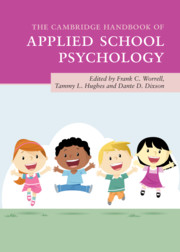Book contents
- The Cambridge Handbook of Applied School Psychology
- The Cambridge Handbook of Applied School Psychology
- Copyright page
- Contents
- Contributors
- Contributor Biographies
- Acknowledgments
- 1 Broadening the Focus of School Psychology Practice
- Part I Individual-Level Academic Interventions
- 2 Enhancing Reading Motivation in Schools
- 3 Addressing “Won’t Do” Issues in Mathematics
- 4 Learning Disabilities in Mathematics
- 5 Executive Function and School Performance
- Part II Teacher- and System-Level Interventions
- Part III Interventions from Educational and Social/Personality Psychology
- Part IV Behavioral and Social-Emotional Interventions
- Part V Health and Pediatric Interventions
- Part VI Family Connections and Life Transitions
- Part VII Special Populations
- Part VIII Conclusion
- Index
- References
5 - Executive Function and School Performance
from Part I - Individual-Level Academic Interventions
Published online by Cambridge University Press: 18 September 2020
- The Cambridge Handbook of Applied School Psychology
- The Cambridge Handbook of Applied School Psychology
- Copyright page
- Contents
- Contributors
- Contributor Biographies
- Acknowledgments
- 1 Broadening the Focus of School Psychology Practice
- Part I Individual-Level Academic Interventions
- 2 Enhancing Reading Motivation in Schools
- 3 Addressing “Won’t Do” Issues in Mathematics
- 4 Learning Disabilities in Mathematics
- 5 Executive Function and School Performance
- Part II Teacher- and System-Level Interventions
- Part III Interventions from Educational and Social/Personality Psychology
- Part IV Behavioral and Social-Emotional Interventions
- Part V Health and Pediatric Interventions
- Part VI Family Connections and Life Transitions
- Part VII Special Populations
- Part VIII Conclusion
- Index
- References
Summary
There has been increased interest in executive function (EF), not only in relation to specific clinical disorders, but also in relation to development and school performance in children and youth who may not have a clinical disorder. EF is associated with self-regulation, effortful control, inhibition, and social-emotional status; deficits in EF may result in maladjustment. Not only predictive of behavioral outcomes, EF is associated with academic performance in both math and reading. With this increased recognition of the importance of EF, approaches to foster development of EF and address EF deficits within a multitiered system of support (MTSS) have been developed. While further research is needed, preliminary results indicate improvements in social-emotional function, behavior, and academic skills, as well as targeted EF skills. The theoretical basis and available research are reviewed, and implications for future research provided.
Keywords
- Type
- Chapter
- Information
- The Cambridge Handbook of Applied School Psychology , pp. 64 - 82Publisher: Cambridge University PressPrint publication year: 2020

